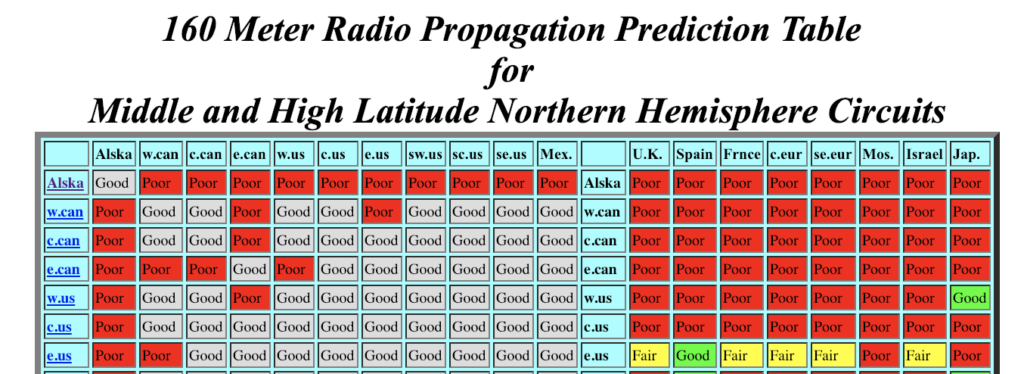160-meter communication between New England states and Alaska can be very challenging due to its high latitude and proximity to the magnetic pole.
To begin with, the path distance is approximately 3,400 miles, which is going to require at least two hops via the F-layer, or three hops via the E-layer. Each of those hops requires two passes through the D-layer. Every pass through the D-layer will attenuate the 1.8 MHz signal (sometimes significantly). Normally the D-layer absorption is quite high, but it can, on occasion, be almost zero during periods of low solar and geomagnetic activity (like now). Today’s D-layer absorption looks like this:

So the above is a good thing; little to no D-layer absorption (at the moment).
But there are other things working against the New England to Alaska route.
Signals must pass through the Auroral Zones on its way down to mid-latitudes. That can completely block the outbound signal. On top of that, the Auroral Zone is sort of a semicircle, and that lower part of the circle often follows the same path that the signals must take to get to New England — in other words, the signal doesn’t just pass through the Auroral Zone, it is trapped by it for thousands of miles. That zone is impacted by the high latitude K-factor. The higher this number, the less likely success will be on the path, as higher numbers tend to indicate increased auroral activity. So the only hope of a contact will be on days with very low K-factors.
Around the latitude of Alaska the F-layer behaves quite differently at night, with a much lower MUF; about a factor of 3 lower than southern states, and 2 lower than northern states. So if the MUF is around 3 MHz in New England (fairly common night time values during lower solar activity periods), then one could expect the MUF to be 1.5 MHz in Alaska — in other words the F-layer will no longer refract signals in the 160 meter band.
The magnetic North Pole is very close to Alaska (and it has been moving closer). This means that the magnetic lines of flux are close to vertical at the pole (they are almost horizontal near the equator).
The current geomagnetic conditions at the Barlow Alaska observatory can be found here: https://geomag.usgs.gov/plots/
Below is a snapshot of the near realtime 160 meter propagation (taken when I made this post at 0200 UTC). Alaska is on the upper right. Note that conditions are “Poor” to everywhere in the world (except Alaska itself). Not very encouraging (I feel bad for Alaskan hams). Just for grins, note the current conditions from the Eastern US (bottom right).
This comes from the following website: http://www.spacew.com/www/160pred.html
Please note at this time the web page appears broken (it never updates)
I contacted Les KL7J, who worked with me on an 80 meter qso about 5 years ago. Les supplied a HF prediction for wintertime AK to RI propagation:
So it appears that 04:30-05:30 UTC and 09:30-10:30 UTC are the best time. That being said, a quote from Les: “I have not heard the east USA since Dec 2017” and “The band has been very poor this winter and the east coast been missing as most of the eastern USA”. Not very encouraging.











Bob, Alaska on 160. I know I have worked Alaska several times on 160 but I took the time on LOTW, (where all my logs go) to figure out how many times. Found out not as many as I thought, only 4 times. The inverted “L” helped a lot though.
Good luck
Hi Bruce,
I was able to complete WAS on 160-meters after working Alaska. It’s always a challenge as the path is polar and absorption is very high in that direction as the flux lines are entering the pole. But persistence paid off around the Equinox (that has a huge impact on it as well). Basically I kept the rig on 24×7 and noted the times that I could hear Alaska. The path is not symmetric either, with much more power is required from the Alaskan ham.
Now the quest is DXCC on 160-meters. 82 countries confirmed and counting.
73, Bob